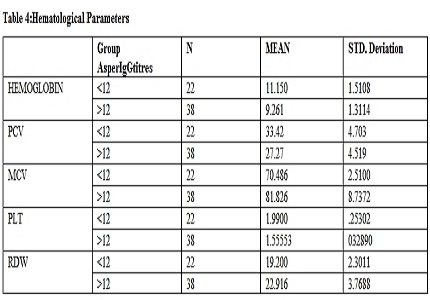Seroprevalance of Helicobacter pylori in undernourished children: A hospital based study
Abstract
Introduction: Helicobacter pylori is a gram negative, spiral flagellated bacillus that persistently colonizes the human stomach. H.pylori incidence in most of the developing countries including India is around 80% and most of the infection is acquired by 10 years of age. In children it is associated with anaemia and undernutrition..We have taken up this study to find out its seroprevalance in undernourished children aged 6-12 years admitted in the hospital for various reasons.
Material and Methods: This is a cross sectional study done over a period of one year in the pediatric department of a teaching hospital. After ethical committee clearance and parental consent, data was collected in a pretested proforma and serology was done for Ig G antibodies against H.pylori.(ELISA) in which a titre of >12micrograms/ml was considered positive.
Results:We studied 60 children who fulfilled our inclusion criteria. The male to female ratio was comparable in the different age groups,with total29 males and 31 females.63.3% of the children tested positive for antibodies against H.pylori. The seropositive children had significantly high tendencyof having symptoms of H.pylori infection. The relation between H.pylori seropositivity and low BMI was significant (p<0.005).72.7% of children who regularly consumed raw vegetables were seropositive but this association was not statistiticallysignificant.Low SES and increased overcrowding indexstatus was significantly associated with seropositivity.LowHb as per age and sex and low PCV were associated with seropositivity.
Conclusion:Our study showed seroprevalance of H.pylori to be 63.3% in undernourished children. LowSES, overcrowding,open field defecation were significantly associated with H pylori infection. Low BMI, anemia and low PCV werestrongly associated with H.pylori seropositivity. Thus we conclude that H.pylori contributes to morbidity of already undernourished children therefore H pylori eradication regimen should be considered in undernourished children with suggestive symptoms.
Downloads
References
2. Johannes GK, van Valiet AHM and Kuipers EJ. Pathogenesis of Helicobacter pylori infection. Clinical Microbiol Rev. 2006 ;19(3): 449-490. [PubMed]
3. Soylu OB, Ozturk Y. Helicobacter pylori infection: effect on malnutrition and growth failure in dyspeptic children. Eur J Pediatr. 2008 May;167(5):557-62. Epub 2007 Jul 6. [PubMed]
4. Suzuki H, Franceschi F, NishizawaT ,Gasbarrini A .Extragastric manifestationof Helicobacter pylori. Helicobacter.2011;16Suppl 1:65-69. [PubMed]
5. Jagdish C Das and Nibedita Paul. Epidemiology and pathophysiology of helicobacter pyloriinfection in children.Indian J of Pediatrics.2007; 74(3): 287-290. [PubMed]
6. Kim JH ,Kim JY, Kim NY, Kim SW et al .Helicobacter pylori infection ,seroepidemiology diagnosis and treatment. J GastroenterolHepatol. 2001;16: 969-975. [PubMed]
7.http://www.who.int/childgrowth/standards/en/.
8. Yelda A Leal,Laura L Flores,Laura B. Garcia –Gortes.Antibody-Based Detection Tests for the Diagnosis of Helicobacter pylori Infection in Children: A Meta-AnalysisPLoS ONE 3(11): e3751. doi: 10.1371/journal.pone.0003751. [PubMed]
9. Gill HH, Majumdaar P, ShankaranK, Desai HG. Age related prevalence of Helicobacter pylori antibodies in Indian subjects .Indian J of Gastroenterology.1994;13:92-99. [PubMed]
10. Poddar U, Thapa BR. Helicobacter pylori infection in children. Indian Pediatrics.2000;37: 275-283. [PubMed]
11. Misra V, Misra SP, Diwedi M, Singh PA. Point prevalence of peptic ulcer and gastric histology in healthy Indians with Helicobacter pylori infection. Am J Gastroeterol 1997; 92: 1487-1489. [PubMed]
12. Jais M, Barua S. Seroprevalence of anti Helicobacter pylori IgG/IgA in asymptomatic population from Delhi. J Commun Dis 2004; 36: 132-135. [PubMed]
13. Fraser AG, Scragg R, Metcalf P, McCullough S, Yeates NJ. Prevalence of Helicobacter pylori infection in different ethnic groups in New Zealand children and adults. Aust N Z J Med 1996;26: 646-651. [PubMed]
14. Rothenbacher D, Bode G, Berg G, Gommel R, Gonser T, Adler G, Brenner H. Prevalence and determinants of Helicobacter pylori infection in preschool children: a population-based study from Germany. Int J Epidemiol 1998;27: 135-141. [PubMed]
15. Bardhan PK. Epidemiological features of Helicobacter pylori infection in developing countries.Clin Infect Dis 1997;25: 973-978. [PubMed]
16. Smith SI, Oyedeji KS, Opere B, I walokun BA, Omonigbehin EA. The effects of some Nigerian local herbs on Helicobacter pylori. Afr J ClinExpMicrobiol 2003; 4: 29-35.
17. Chong SK, Lou Q, Zollinger TW, Rabinowitz S, Jibaly R, Tolia V, Elitsur Y, Gold BD, Rosenberg A, Johnson A, Elkayam O, Rosenthal P, Gilger M, Li BU, Peacock JS. The seroprevalence of Helicobacter pylori in a referral population of children in the United States. Am J Gastroenterol 2003;98: 2162-2168. [PubMed]
18. Singh M, Prasad KN, Yachha SK, Saxena A, Krishnani N. Helicobacter pylori infection in children: prevalence, diagnosis and treatment outcome. Trans R Soc Trop Med Hyg 2005; 27: 227-233. [PubMed]
19. Biswal N, Ananthakrishnan N, Kate V, Srinivisan S, Nalini P, Mathai B. Helicobacter pylori and recurrent pain abdomen. Indian J Pediatr 2005; 72: 561-565. [PubMed]
20. Das BK, Kakkar S, Dixit VK, Kumar M, Nath G, Mishra OP. Helicobacter pylori infection and recurrent abdominal pain in children. J Trop Pediatr 2003; 49: 250-252. [PubMed]
21. Haque W, Ahsan CR, Nessa J and Yasmin M.Associationbetween malnutrition and other possible risk elements with theacquisition of H. pylori infection among the children population in Bangladesh. Bang J Microbiol.2009; 26(1&2): 9-14.
22. Idowu O Senbanjo1, KazeemA Oshikoya2, Olisamedua F Njokanma. Helicobacter pylori associated with breastfeeding, nutritional status and recurrent abdominal pain in healthy Nigerian children. Journal of Infect.Dev. Ctries.2014;8(4):448-453 doi:10.3855/jidc.3196.
23. MalatyHM,and Graham DY. Importance of childhood socioeconomic status on the currentprevalence of Helicobacter pylori infection. Gut.1994;35(6): 742-745.Gutv.35(6); 1994 JunPMC1374869.
24. Koike T, Ohara S, Sekine H, Iijima K, Abe Y, Kato K, Toyota T, Shimosegawa T. Helicobacter pylori infection preventserosive reflux oesophagitis by decreasing gastric acid secretion. Gut 2001; 49: 330-334. [PubMed]

Copyright (c) 2016 Author (s). Published by Siddharth Health Research and Social Welfare Society

This work is licensed under a Creative Commons Attribution 4.0 International License.


 OAI - Open Archives Initiative
OAI - Open Archives Initiative


